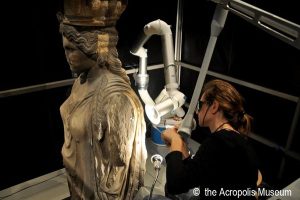Facility type: FIXLAB
Access provider: Photonics for Heritage Science, IESL
Title: Laser conservation
Description
The goal of FIXLAB facility at FORTH (PhoHS-FORTH) is to respond to diverse conservation and cleaning challenges by developing and implementing optimum laser cleaning methodologies for CH assets followed with dedicated methodologies for the assessment of the treated surfaces and the monitoring of the cleaning interventions.
The unique facilities offered by PhoHS-FORTH over the past 25 years embrace several laser systems operating at different wavelengths, pulse durations and modes, dedicated assessment and evaluation facilities and a highly experienced team of experts in the field. A number of laser cleaning accessory workstations have been developed at FORTH in order to handle the different types of conservation problems individually and approach the various laser cleaning challenges, such as a computer-controlled beam steering system for a high precision smooth laser scanning over the object (for the cleaning of paintings and large flat/homogeneous surfaces) and a XY motorized, computer-controlled stage for translating the object with respect to the laser beam. Additionally, a laser cleaning support station equipped with glovebox and exhaust hood for handling materials producing emissions of dust or volatiles has been also developed at the laboratory.
Services
Removal of unwanted layers from original surfaces, such as
- pollution or burial encrustations from stone sculptures,
- corrosion from metals,
- aged varnish layers or over-paintings from paintings
- salts from wall-paintings
- graffiti from stone substrates
Technical Info
UNIT-1, which is dedicated to the laser-assisted reduction of aged/polymerised organic coatings (varnish, protection films, etc.) from paintings is composed of:
- A laser system emitting in the UV,
- A beam guiding system that delivers/directs the laser beam (of adjustable fluence, size and repetition rate) onto the painting surface. On the basis of a well-defined protocol, this computer-driven mechanized component enables the homogeneous scanning of a predefined area, and
- A number of multi-modal diagnostic instruments for in-situ assessment of the cleaning result and monitoring of the laser ablation procedure. These can be selected according to the specifications of each individual cleaning case and may be one or more of the following: Spectral Imaging to visualise the cleaning state, Laser-Induced Fluorescence (LIF) to evaluate the thinning of varnish, Vis – NIR Diffuse Reflectance spectroscopy to chemically characterise the irradiated surfaces, Photoacoustic sensors to monitor the cleaning process, and so on.
Max dimension of paintings with the current unit geometry: 50 cm x 50 cm. Larger objects may be hosted upon discussion and planning.
UNIT-2, which refers to laser-assisted removal of complicated cleaning on the basis of double wavelength Nd:YAG lasers is based on:
A QS Nd:YAG laser emitting in different frequencies (1064nm, 532nm, 355nm, etc.) specially modified to use synchronously two of the wavelengths in spatial and temporal overlapping offers a convenient basis to exploit the possibility to combine the different cleaning mechanisms (i.e. the IR at 1064 nm and UV at 355 nm). The key feature is the adjustment of the energy density ratio of the two beams (i.e. FIR/FUV) and thus the regulation of the contribution of the individual ablation mechanism for different encrustations and substrates.
Similarly to the other unit a number of multi-modal diagnostic instruments for in-situ assessment of the cleaning result and monitoring of the laser ablation procedure may be adjusted to the cleaning set-up. These can be selected according to the specifications of each individual cleaning case and maybe one or more of the following: Spectral Imaging to visualize the cleaning state, Vis – NIR Diffuse Reflectance spectroscopy to chemically characterise the irradiated surfaces, Photoacoustic sensors to monitor the cleaning process, and so on.
Examples/Photos
|
|
Related Publications
- “Laser cleaning of paintings: in situ optimization of operative parameters through non-invasive assessment by optical coherence tomography (OCT), reflection FT-IR spectroscopy and laser induced fluorescence spectroscopy (LIF)”, P. Moretti, M. Iwanicka, K. Melessanaki, E. Dimitroulaki, O. Kokkinaki, M. Daugherty, M. Sylwestrzak, P. Pouli, P. Targowski, K.J. van den Berg, L. Cartechini and C. Miliani, Heritage Science, 2019, 7:44, https://doi.org/10.1186/s40494-019-0284-8
- “Recent studies of laser science in paintings conservation and research”, P. Pouli, A. Selimis, S. Georgiou, C. Fotakis, Accounts of Chemical Research, 43(6), 771-781 (2010); doi:10.1021/ar900224n.
- “Laser Cleaning and Spectroscopy: A Synergistic Approach in the Conservation of a Modern Painting,” K. Melessanaki, C. Stringari, C. Fotakis, D. Anglos, Laser Chemistry, vol., Article ID 42709, 5 pages, (2006); doi:10.1155/2006/42709.
- “The two-wavelength laser cleaning methodology; Theoretical background and examples from its application on CH objects and monuments with emphasis to the Athens Acropolis Sculptures”, P. Pouli, E. Papakonstantinou, K. Frantzikinaki, A. Panou, G. Frantzi, C. Vasiliadis, C. Fotakis, Heritage Science, 4:9 (2016); doi: 10.1186/s40494-016-0077-2.
- “Practical issues in laser cleaning of stone and painted artefacts: optimization procedures and side effects”, P. Pouli, M. Oujja, M. Castillejo, Applied Physics A 106(2), 447-464 (2012); doi:10.1007/s00339-011-6696-2.
- “Laser-assisted removal of dark cement crusts from mineral gypsum (selenite) architectural elements of peripheral monuments at Knossos”, G. Grammatikakis, K.D. Demadis, K. Melessanaki, P. Pouli, Studies in Conservation, 60 (S1), S3-S11 (2015); doi: 10.1179/0039363015Z.000000000201.
- “Development of a hybrid photoacoustic and optical monitoring system for the study of laser ablation processes upon the removal of encrustation from stonework”, Athanasia Papanikolaou, George J. Tserevelakis, Kristalia Melessanaki, Giannis Zacharakis, Paraskevi Pouli, OEA Feb 2020 {accepted in press}
- “Laser cleaning studies for the removal of tarnishing from silver and gilt silver threads in silk textiles” B. Taarnskov, P. Pouli, J. Bredal-Jørgensen, in Lasers in the Conservation of artworks VIII, eds R. Radvan, J. Asmus, M. Castillejo, P. Pouli, A. Nevin, CRC Press, Taylor and Francis Group, London (2011) 67-73; doi:10.1201/b10567-12.
- “Investigating and optimizing the laser cleaning of corroded iron”, C. Korenberg, A.M. Baldwin, P. Pouli, In the Proceedings of the 7th International Conference on Lasers in the Conservation of Artworks (LACONA VII), Series Eds. Castillejo et al., Taylor and Francis group, London, 285-290 (2008).

